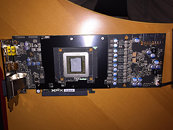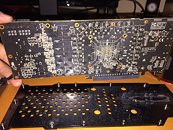Sunday, June 14th 2015

Radeon R9 390X Taken Apart, PCB Reveals a Complete Re-brand
People with access to an XFX Radeon R9 390X graphics card, took it apart to take a peek at its PCB. What they uncovered comes as no surprise - the underlying PCB is identical in design to AMD reference PCB for the Radeon R9 290X, down the location of every tiny SMT component. At best, the brands on the chokes and bigger conductive polymer caps differ; and 512 Gbit GDDR5 chips under the heatspreader, making up 8 GB of the standard memory amount. The GPU itself, codenamed "Grenada," looks identical to the "Hawaii" silicon which drove the R9 290 series. It's highly unlikely that it features updated Graphics CoreNext 1.2 stream processors, as older rumors suggested.
Sources:
1, 2


89 Comments on Radeon R9 390X Taken Apart, PCB Reveals a Complete Re-brand
Can you not see the parallel between the FX back then and the lack of innovation in GPU right now? AMD has started a trickle down attempt with HBM and forced itself into a third rebrand because HBM is too costly for anything but the top end card. Not a smart decision when Nvidia shows the world there is efficiency to be gained, and not just a little of it either.
It happens every time with AMD. Their lack of R&D is converted into a higher production cost, and they just fail to see it. Again. And Again. AMD's answer to lacking efficiency gains is 'more cores' which results in higher cost AND a product that is less competitive across the board. And because the product is less competitive, it goes for a lower price. All aspects of this way of doing business result in reduced margins and profit. Evidenced by the yearly results.
This is the essence of the problem. Now, to look ahead: what is the core setup of Zen again? Oh yeah, a many-core design.
Things have just changed.
AMD’s R&D and wows from making Bulldozer are not absolutely same as the cash flow troubles that the GPU side is sullied with today. Sure the loss of profit on the CPU side has had an effect, but it’s the overall health of a lot of bad decisions that weigh on GPU side. To even make that parallel is simplistic.
I don't see the FX and these GPU's as drawing any parallel other than their implementation of Asynchronous Shading, and attaining actual use of multi-core that they hoped the software programing world would “get one board” too the usefulness of that back 7 years ago.
AMD is known to push technology well head of the industry (aka 64-Bit) the idea of true “multi-core” has been the courageous path, and AMD went “all in” on chip designs believing if we build it the industry will change... NOT. Not to say there wasn’t shortcomings even in the "core design" that hampered multi-path coding, yes. It was more AMD neglected to comprehend that single-core (hyper-thread) was "super embedded" and software writing wasn't going to change to their idea’s without a hook.
When we now look a Dx12, Asynchronous Shading, FX processor multi-core, the need to why AMD introduce Mantle… their direction is apparent. They’ve in some ways now nudged/forced Microsoft to step-up, and offer the significances that AMD's technologies have been building to (kind of 64-Bit all over again). We need to step back (realize) the David-Goliath(s) that are in the industry hold to what they like till they can offer it, in that vain the Intel/Nvidia consortium was not into Microsoft going to low level API. This time I see AMD pressing Mantle challenged Microsoft, showing they might be best to move, or see their dominance in PC Gaming (DX) brought down by other groups the likes Steam machines, Linux, even Apple as they seem to be looking at low level API gaming.
AMD's Fiji is less than 1% smaller than GM 200 - so while technically correct, I wouldn't tout it as a plus. The other point is that we've yet to see Fiji benchmarked, and the only implementations of GM 200 seen are a full part that is wattage constrained by a large framebuffer and adherence to the ATX spec, and a salvage part. Neither are representative of the zenith of the architecture. I am going to hazard a guess that if Nvidia plumbed the Titan X for dual 8-pin input and raised the board power limits accordingly, you would see some significant uplift.
If you were talking SKUs, I wouldn't make the comparison, since Nvidia tend to value the ATX and PCI-SIG spec and their warranties over outright performance, but you were talking architecture - and while Fiji and HBM is undoubtedly a big step forward, just like GM 200 is a scaled up GM 204 which made concessions in design itself, I suspect that Fiji grew out of Tonga and could well be making concessions of its own.True. AMD's woes stem from decisions made at board level ten years ago.
Don't get me wrong, I like how AMD's philosophies are now coming to fruition, but the expenses are way too high.
Innovation is the price of Greatness, and yes sometime it doesn't pay off. And sometime it take bold moves as when Apple on verge collapse bring back Steve Job's, he had to make cozy with Bill Gates. Every Apple fan decried the relationship, but it got Apple we have today. I think this time AMD wrangled Microsoft to include such that "innovations," which they weren't intending to include because "industry leaders" had the ear of MS. Then AMD said, here's what Gamers could have, and it isn't or doesn't need to be tied just to MS and their ecosystem...
Philo Farnsworth; an Idaho farm boy at the age 15 developed the working concept of TV, built the prototype and he got the Patent. Even won Patent injunctions, against RCA (the industry leader in radio) who poured exorbitant amounts of money to stifle him in court, completely stopping ever getting into production. RCA finally found a way to circumvent those patents and general public doesn’t know or acknowledges Farnsworth with the invention of TV.
I suppose I see it differently, as being more the basis of an American Sprit to innovation.
The American Dream is... different the Sprite to dream and develop things; while there's something to be said when America still had some... idea of frugality.
So true, not a "whit-worth" of difference.
Here's what we do know.
1. The memory is sped up by 500-1000Mhz, advances in circuitry made this possible.
2. The VRM cooler is heavy, rough estimates are 20-30'C cooler from the previous 290s
3. Bigger cooler, more copper
More on that next week when i have parts on hand and reviews start coming in
:cool: